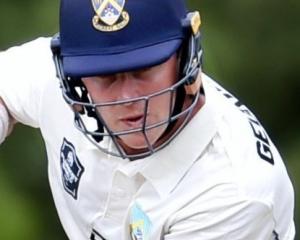The Plunket Shield match between Otago and Canterbury starting in Dunedin today marks the 150th anniversary of first-class cricket in New Zealand. Gavin Bertram reports.

The Dunedin entrepreneur's vision in the early 1860s means that this week marks the 150th anniversary of first-class cricket in this country.
The inaugural first-class match was between Otago and Canterbury on January 27-29, 1864. Serendipitously, the same two provinces meet again for a first-class Plunket Shield match in Dunedin this week.
Jones was a fascinating character. Born in England in 1822, he qualified as a doctor at Scotland's St Andrews University, then followed the trail of gold first to Bendigo, in Australia, and then to Dunedin in 1861. As the city burgeoned during the Otago Gold Rush, Jones prospered.
Soon he was proprietor of the Provincial and Commercial Hotels, as well as the Theatre Royal and Princess Theatre. Jones successfully promoted visits by the likes of the San Francisco Minstrels and the English Opera Company, but his most daring move involved cricket.
During late 1863 and early 1864, George Parr's All England XI was visiting Australia - just the second international team to have toured in the Antipodes. Jones successfully negotiated to have the All England XI add a visit to Dunedin and Christchurch to its itinerary. He created the ambitious Dunedin Cricketing Festival, wherein Otago, Southland and Canterbury teams would face each other and the accomplished English visitors.
Cricket in New Zealand was in its infancy, although the game in Dunedin had benefited from the population influx caused by the gold rush. The Dunedin Cricket Club, formed the year after the city's foundation in 1848, was naturally at the centre of the game in the city.
By 1863 the club was developing its ground at the Kensington Oval - then known as the Southern Recreation Ground. With labour provided by the Provincial Council, the swampy area was drained with trenches and water channels.
Greg Ryan's book The Making of Cricket in New Zealand 1832-1914 notes that ''by the end of November tour funds were such as to allow a tender for the enclosure of the ground with 600 yards of 7-foot-high paling fence and the building of a 375-foot-long grandstand. On completion, opinion was expressed that the facilities were as good as those in Melbourne''.
With the venue in place, Jones began to build cricketing excitement in Dunedin leading up the visit of the All England XI in February 1864.
On Boxing Day 1863, a match between the Dunedin Cricket Club and a Jones XI attracted more than 3000 spectators to the ground - perhaps a quarter of the city's swelling population.
Otago met Southland in the first match of the Dunedin Cricketing Festival on January 23-24, 1864. In wet weather, the local side easily took the honours, amassing 222 runs before dismissing Southland for 45 and 34. Captain Henry Maddock did the damage, taking five wickets for 16 runs, and then seven for 23.
The stage was set for the very first meeting between Otago and Canterbury, a three-day match beginning on January 27.
The Otago Daily Times reported on the first day of play that, ''The first Inter-provincial Match in New Zealand will be commenced today, on the ground of the Dunedin Club, at the Recreation Ground. A capital game is expected; and it will be watched with much interest.''
The Otago side, selected by the Dunedin Cricket Club, was: Charles Morris, John Jacomb, Christopher Mace, John Hope, captain James Redfearn, Fred Macdonald, James Fulton, John Mace, Richard Coulstock, Gibson Turton and Henry Maddock.
Several (Jacomb, Redfearn, Coulstock and both Maces) had already had a taste of first-class cricket, playing for Victoria in Australia.
They met the Canterbury team of: Walter Wilson, Arthur Powys, Augustus Tennant, Henry Lance, Edward Stevens, George Sale, Joseph Bennett, Henry Mytton, John Stevens, George Dickinson, and Robert Taylor.
The visitors did not find the conditions to their liking, Men In White: The History of New Zealand Cricket noted.
''The Cantabrians had practised on firm wickets at Hagley Park and were ill-prepared for the quagmire awaiting them after they had battled south by sea against gale-force winds. Although the Oval had been recently turfed as a gesture to the visiting Englishmen, recent rain and the fact that cattle had wandered over the ground the night before the match made for atrocious conditions.''
Few Dunedin spectators were prepared to pay one shilling to enter the enclosure, or two shillings and sixpence for the grandstand, the ODT reported. Many gathered on the opposite hill and on some ''small mounds'' around the enclosure.
In fine conditions, the match began at noon, with Canterbury captain Lance winning the toss and putting Otago in to bat.
Morris faced the first first-class cricket delivery in New Zealand, bowled by either Taylor or Stevens.
Neither Morris nor fellow opener Jacomb stayed at the crease long, and soon Otago was three wickets down for just seven runs. Fulton's 25 not out anchored an innings total of 78 from 60 overs - poor by modern standards, but a reasonable effort given the state of the pitch.
Canterbury bowler Taylor took six wickets for 21 runs, with 10 maidens from his 22.2 overs.
Otago only required the bowling services of Macdonald and John Mace to dismiss Canterbury for 34, ''the batsmen apparently being puzzled with the swift bowling'', according to the ODT.
No batsman scored double figures as Macdonald took four for 14 and Mace four for 16, along with two run outs.
Otago's second innings was similar to the first, with the openers contributing little, and the middle-order of Redfearn, Hope and Macdonald contributing most of the 74 runs.
On the third day, Canterbury was chasing 119 to win, which given the previous three innings didn't seem likely.
''Though the work cut out for Canterbury was uphill, to win was by no means an impossibility, and the odds that were freely offered the evening previous became considerably reduced,'' the ODT reported.
Again, Otago's bowlers cut through the Canterbury batsmen, with Macdonald returning figures of six for 17, and Mace four for 20.
With Canterbury out for 42, the match was all over by 1pm, with Otago winning by 76 runsThe gravity of Otago's win in this match was overshadowed by the public's anticipation of the arrival of the All England XI several days later.
But not only did Otago's victory mark the arrival of first-class cricket in New Zealand, it spawned a provincial sporting rivalry that is now 150 years old.












